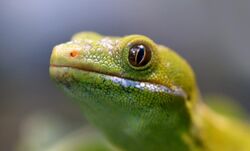Biology:Northland green gecko
| Northland green gecko | |
|---|---|

| |
| at Orana Wildlife Park, Christchurch | |
| Scientific classification | |
| Domain: | Eukaryota |
| Kingdom: | Animalia |
| Phylum: | Chordata |
| Class: | Reptilia |
| Order: | Squamata |
| Family: | Diplodactylidae |
| Genus: | Naultinus |
| Species: | N. grayii
|
| Binomial name | |
| Naultinus grayii Bell, 1843
| |
| Synonyms[2] | |
| |
The Northland green gecko (Naultinus grayii), also known commonly as Gray's tree gecko is a species of lizard in the family Gekkonidae. The species is found only in the Northland region of New Zealand, north of Whangaroa; it is one of the rarest and most highly sought after lizards.[3]
Taxonomy
Naultinus grayii was originally described by Thomas Bell in 1843.[3]
Etymology
The specific name, grayii, is in honour of British herpetologist John Edward Gray.[4]
Habitat
The preferred natural habitats of N. grayii are freshwater wetlands, shrubland, and forest.[5]
Description
The Northland green gecko is vivid green with grey or gold-coloured markings on either side along the dorsal surface. Males have a blue band along the sides just below the limbs.[citation needed] Underneath, the ventral surface of both sexes is bright pale green, sometimes with a yellow tinge. The inside of the mouth is deep blue with a bright red tongue.[citation needed]
Its total length (including tail) is up to 200 mm (7.9 in),[citation needed] and its snout-to-vent length (SVL) is up to 95 mm (3.7 in).[5]
Behaviour
The Northland green gecko is diurnal,[5] often found sun-basking.[citation needed] It has an arboreal lifestyle,[citation needed] especially favouring stands of manuka, kanuka,[5] and mingimingi.[citation needed]
Reproduction
N. grayii is oviparous.[2] Average litter size is two newborns.[5] Sexual maturity is reached at approximately two years, after which reproduction occurs annually.[5] The young are born in March, after a gestation period of four months.[5]
Conservation status
In 2012 the Department of Conservation classified the Northland green gecko as "At Risk" under the New Zealand Threat Classification System. It was judged as meeting the criteria for "At Risk" threat status as a result of it having a low to high ongoing or predicted decline. This gecko is also regarded as being "Data Poor".[6]
Captivity
The species N. grayii, like all the Naultinus species, is regarded as the "holy grail" of geckos among their keepers, often going for a large amount of money for a pair of lizards.[citation needed] Outside of its home range, it is most commonly kept in Europe where there are several keepers producing offspring, though still extremely rarely seen.[citation needed]
In 2001 a German tourist was fined $12,000 for attempting to smuggle Northland green geckos out of the country in his underwear.[7]
See also
- Geckos of New Zealand
References
- ↑ "Appendices | CITES". https://cites.org/eng/app/appendices.php.
- ↑ 2.0 2.1 Species Naultinus grayii at The Reptile Database www.reptile-database.org.
- ↑ 3.0 3.1 "Featured Species". http://emsworthreptiles.co.uk/featured.shtml.
- ↑ Beolens, Bo; Watkins, Michael; Grayson, Michael (2011). The Eponym Dictionary of Reptiles. Baltimore: Johns Hopkins University Press. xiii + 296 pp. ISBN:978-1-4214-0135-5. (Naultinus grayii, p. 107).
- ↑ 5.0 5.1 5.2 5.3 5.4 5.5 5.6 Hitchmough R, van Winkel D, Lettink M, Chapple D (2019). "Naultinus grayii ". The IUCN Red List of Threatened Species 2019: dx.doi.org/10.2305/IUCN.UK.2019-2.RLTS.T120188965A120192544.en. Accessed on 18 September 2023.
- ↑ Cite error: Invalid
<ref>tag; no text was provided for refs namedConservation 2012 - ↑ "Convicted Gecko smuggler gets.". New Zealand Government. 1 February 2001. http://www.beehive.govt.nz/release/convicted+gecko+smuggler+gets. Retrieved 30 June 2010. [|permanent dead link|dead link}}]
Further reading
- Bell T (1843). The Zoology of the Voyage of H.M.S. Beagle Under the Command of Captain Fitzroy, R.N., during the years 1832 to 1836. Edited and Superintended by Charles Darwin ... Naturalist to the Expedition. Part 5., Reptiles. London: Smith, Elder and Company. vi + 51 pp. + Plates 1-20. (Naultinus grayii, new species, pp. 27–28 + Plate 13, figure 2). (in English and Latin).
- Buller W (1871). "A List of the Lizards inhabiting New Zealand, with Descriptions". Transactions and Proceedings of the New Zealand Institute 3: 4–11. (Naultinus grayii, pp. 7–8).
- Nielsen SV, Bauer AM, Jackman TR, Hitchmough RA, Daugherty CH (2011). "New Zealand geckos (Diplodactylidae): Cryptic diversity in a post-Gondwanan lineage with trans-Tasman affinities". Molecular Phylogenetics and Evolution 59 (1): 1-22.
Wikidata ☰ Q3019031 entry
 |



